Readings Newsletter
Become a Readings Member to make your shopping experience even easier.
Sign in or sign up for free!
You’re not far away from qualifying for FREE standard shipping within Australia
You’ve qualified for FREE standard shipping within Australia
The cart is loading…






This title is printed to order. This book may have been self-published. If so, we cannot guarantee the quality of the content. In the main most books will have gone through the editing process however some may not. We therefore suggest that you be aware of this before ordering this book. If in doubt check either the author or publisher’s details as we are unable to accept any returns unless they are faulty. Please contact us if you have any questions.
This is now the fourth time that protein phosphorylation has been the focus of a NATO Advanced Study Institute. The first meeting with the topic Signal Trans duction and Protein Phosphorylation was held on the island of Spezai, Greece, in September 1986. The second one took place in Chateau La Londe, France, in September 1989 on Cellular Regulation by Protein Phosphorylation , the third one on
Tyrosine Phosphorylation/Dephosphorylation and Downstream Signaling was in September 1992 in Maratea, Italy. The titles of these books clearly mirror the developments that have taken place in the last decade. Beginning with the recognition that protein phosphorylation is at the center of signaling -clearly established in 1990 -it became apparent that many cellular processes are regulated by this mode. A new focus then emerged when it was recognized that growth factors are bound to corresponding receptors trigger protein tyrosine phosphorylation which controls cell prolifera tion. This was the topic of the third meeting in this series. It is now evident that further progress depends on understanding the three dimensional structure of the proteins involved. It goes without saying, for example, that understanding the location of proteins by adaptor proteins is only possible on the basis of the three dimensional protein structure. Therefore, the fourth meeting in this series concentrated on the protein structure of signaling molecules as well as on the elucidation of the principles of protein domain interactions.
$9.00 standard shipping within Australia
FREE standard shipping within Australia for orders over $100.00
Express & International shipping calculated at checkout
This title is printed to order. This book may have been self-published. If so, we cannot guarantee the quality of the content. In the main most books will have gone through the editing process however some may not. We therefore suggest that you be aware of this before ordering this book. If in doubt check either the author or publisher’s details as we are unable to accept any returns unless they are faulty. Please contact us if you have any questions.
This is now the fourth time that protein phosphorylation has been the focus of a NATO Advanced Study Institute. The first meeting with the topic Signal Trans duction and Protein Phosphorylation was held on the island of Spezai, Greece, in September 1986. The second one took place in Chateau La Londe, France, in September 1989 on Cellular Regulation by Protein Phosphorylation , the third one on
Tyrosine Phosphorylation/Dephosphorylation and Downstream Signaling was in September 1992 in Maratea, Italy. The titles of these books clearly mirror the developments that have taken place in the last decade. Beginning with the recognition that protein phosphorylation is at the center of signaling -clearly established in 1990 -it became apparent that many cellular processes are regulated by this mode. A new focus then emerged when it was recognized that growth factors are bound to corresponding receptors trigger protein tyrosine phosphorylation which controls cell prolifera tion. This was the topic of the third meeting in this series. It is now evident that further progress depends on understanding the three dimensional structure of the proteins involved. It goes without saying, for example, that understanding the location of proteins by adaptor proteins is only possible on the basis of the three dimensional protein structure. Therefore, the fourth meeting in this series concentrated on the protein structure of signaling molecules as well as on the elucidation of the principles of protein domain interactions.